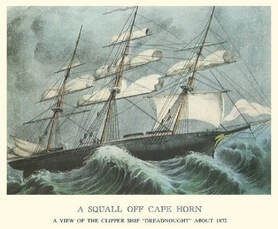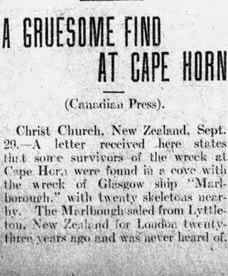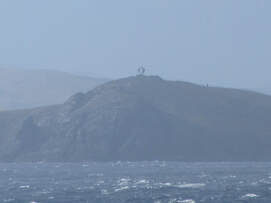 By M.P. Pellicer | Stranger Than Fiction Stories In 1913, a telegram was sent from New Zealand to London, which solved a 23-year-old mystery.  Announcement for the Marlborough in the newspaper c.1890 Announcement for the Marlborough in the newspaper c.1890 The Marlborough sailed from Lyttleton, New Zealand with several passengers and a crew of 33 under the command of Captain W. Hird in January, 1890. She was a vessel of the Shaw, Savill and Albion Company's fleet, measuring 228 feet long, 35 feet broad and 21 feet deep with 1124 tons. The ship carried a cargo of frozen mutton and wool. She set out on the long journey in the teeth of the winter gales of the South Pacific, and once around the Horn, the Marlborough would get on the last leg of the 7,000 miles voyage to the River Clyde in Scotland.  Unidentified tall ship near Cape Horn in stormy seas Unidentified tall ship near Cape Horn in stormy seas She was last seen in the southern Pacific after which no other word was ever heard. It was believed she had gone to the bottom of the ocean in a winter hurricane. Three months later she was posted as missing, and given up as having been lost around the Horn, where the bones of many a good ship and hundreds of seamen lay. A government cruiser was sent out to look for her, and it searched the coast of Patagonia, but nothing was found. She became another mystery of the sea. In September, 1913, a British sailing ship arrived in Lyttleton with the story that the Marlborough had been found, with the skeleton of 20 of her crew in one of the rocky coves near Punta Arenas in the Magellan Strait. The captain's story was this: We were off the rocky coves near Punta Arenas keeping near the land for shelter. The coves are deep and silent, the sailing difficult and dangerous.  The Marlborough and the remains of her crew were found in 1913 The Marlborough and the remains of her crew were found in 1913 There were three large tents erected, and big heaps of shellfish which had been consumed by the survivors. Hundreds of ships pass through Punta Arenas, which is a large town as South American towns go. It had a population of several thousand, and of course the Magellan Strait is a great highway traversed by hundreds of ships yearly. The whole of the Magellan Strait, from Cape Virgus to Cape Pillar was familiar to thousands of seamen, and indented and rockbound though it is, it seems incredible that a ship could lie concealed near a place like Punta Arenas Had the discovery been made among the desolate isles of the Cockburn Channel or down about Cook Bay or False Cape Horn, it would have been more credible.  Albatross monument to all the sailors who lost their lives sailing around Cape Horn Albatross monument to all the sailors who lost their lives sailing around Cape Horn Shortly after the ship was lost there was a report that the crew of a passing ship, saw seamen signaling from an island down that way, which is 300 or 400 miles from Punta Arenas, but the weather was bad and they found it impossible to render aid. The crew were mostly Scots. There were three Peterhead men in the vessel; Alexander Samuel, the chief officer, James Gavin the ship's carpenter and Cowie the sailmaker. There were others that were shipwrecked off Cape Horn, but had better luck. In 1890, J.H. Rogers of Charleston, South Carolina left in early 1888, and shipped from New York on a Hamburg line steamer. He returned after being absent for two years, during which time none had heard from him. He said that he was with the crew of the Montrose, which was burned off Cape Horn in 1888, and that he and the crew lived for over a year on the coast of Patagonia, before they were taken off by a passing ship. During this time they subsisted entirely on mussels and seals.  Sailors could only earn the Homeward Bound tattoo if they rounded Cape Horn Sailors could only earn the Homeward Bound tattoo if they rounded Cape Horn Cape Horn (Cabo de Hornos) was discovered and first rounded by the Dutchman Willem Schouten, who named it Kaap Hoorn after the city of Hoorn in the Netherlands. The waters around Cape Horn are dangerous owing to strong winds, enormous waves, strong currents and icebergs. It has become the graveyard for over 800 ships and 10,000 seamen. This trade route was feared as a necessary evil, and tattoos could only be earned by those who completed the trip around the Horn. Historically, a sailing ship with full rigging and the phrase "Homeward Bound" were tattooed on either the chest, or the back due to the need for a large canvas. Only a sailor who circumnavigated Cape Horn could wear an earring, and always on the on the ear that had faced the mainland. It wasn't until the opening of the Panama Canal in 1914, that there was a shorter and safer route.  Albatross Monument with lighthouse behind it on Hornos Island (Cape Horn) as seen off the coast Albatross Monument with lighthouse behind it on Hornos Island (Cape Horn) as seen off the coast Beneath the Albatross monument is a plaque in Spanish which translates into: I, the albatross that awaits for you at the end of the world... I, the forgotten soul of the sailors lost that crossed Cape Horn from all the seas of the world. But die they did not in the fierce waves, for today towards eternity in my wings they soar in the last Crevice of the Antarctic winds.
0 Comments
Your comment will be posted after it is approved.
Leave a Reply. |
Stranger Than Fiction StoriesM.P. PellicerAuthor, Narrator and Producer Archives
July 2024
Categories
All
|
Stories of the Supernatural
- Stories of the Supernatural
- Miami Ghost Chronicles
- M.P. Pellicer | Author
- Stranger Than Fiction Stories
- Eerie News
- Supernatural Storytime
-
Astrology Today
- Tarot
- Horoscope
- Zodiac
-
Haunted Places
- Animal Hauntings
- Belleview Biltmore Hotel
- Bobby Mackey's Honky Tonk
- Brookdale Lodge
- Chacachacare Island
- Coral Castle
- Drayton Hall Plantation
- Jonathan Dickinson State Park
- Kreischer Mansion
- Miami Biltmore Hotel
- Miami Forgotten Properties
- Myrtles Plantation
- Pinewood Cemetery
- Rolling Hills Asylum
- St. Ann's Retreat
- Stranahan Cromartie House
- The Devil Tree
- Trans-Allegheny Lunatic Asylum
- West Virginia Penitentiary
- Paranormal Podcasts
"When misguided public opinion honors what is despicable and despises what is honorable, punishes virtue and rewards vice, encourages what is harmful and discourages what is useful, applauds falsehood and smothers truth under indifference or insult, a nation turns its back on progress and can be restored only by the terrible lessons of catastrophe."
- Frederic Bastiat
- Frederic Bastiat

Copyright © 2009-2024 Eleventh Hour LLC. All Rights Reserved ®
DISCLAIMER
DISCLAIMER
 RSS Feed
RSS Feed
















